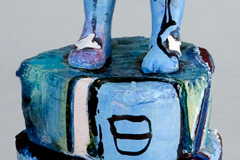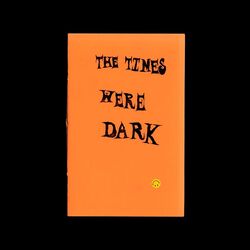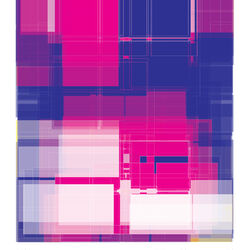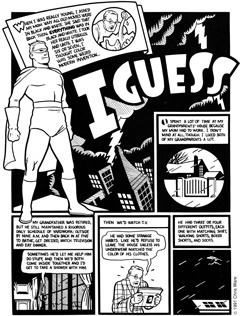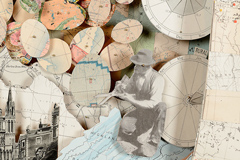Art Dept. Faculty Work
Lisa Marie Barber
Professor
Ceramics, Foundations
Email | Personal Web Site | Faculty Profile
"The majority of my ceramic work, often formatted as figures within dense environments, portrays how I wish to understand people in the world. I strive to create worlds composed of multiple, individualized parts, meant to be celebratory, shrine-like collections. Within them, the human is presented as a passive being, aware of life's weight, yet confident in its value. Often, the figures are children. Chosen for their purity of being, I use children as models of simplistic, unalienated living. To me, they represent a connection to the world that can be simultaneously awkward and full of possibility. In addition to these large-scale sculptures and installations, I also create series of paintings, drawings, and mixed-media works in the forms of quilts and assemblage sculpture. These works explore similar themes, as well as divergent subject matter."
Trenton Baylor
Associate Professor
Sculpture, Woodworking, Digital Fabrication
Email | Personal Web Site | Faculty Profile
Born and raised in Milwaukee, WI, Trenton Baylor earned a bachelor's degree in art and Certification to Teach Art (K-12) from the University of Wisconsin –Parkside '96 and a Master of Fine Arts degree from the University of Wisconsin Madison ’99. He is currently a tenured faculty member in the Art Department at the University of Wisconsin-Parkside where he teaches Sculpture, Digital Design and Fabrication, and Woodworking and Furniture Design courses. He continues to exhibit his sculpture in local, regional, and national exhibitions and has several works in public and private collections.
Tom Berenz
Associate Professor
Painting, Foundations
"My paintings are about my relationship to the world around me; cerebral and physical, intellectual and visceral. I use the disaster motif as a metaphor to discuss personal, sociopolitical, environmental and ideological issues. Through the motif of disaster, I explore the existential self and examine personal narratives, with some being more literal and others more enigmatic. Notions of loss, place, memory, space and time are central as I reexamine personal experiences from my past and present. The imagery is in constant flux, but always returns to a pile. A pile is everything and it is nothing. It is a mound that once was and now isn't; a mass of information, both physical and metaphysical, organized and chaotic. I am interested in blurring the lines between realism and abstraction, life and death, beauty and horror, devastation and sublime. Everything we live with as Americans is delicately balanced-the cars (magic carpets/ death traps), houses (castles/ prisons), and wilderness (paradise/oblivion)."
Lindsey Larsen
Assistant Professor
Graphic Design
Email | Personal Site | Faculty Profile
“My work is an interstitial approach to the graphic arts that moves beyond a discipline-specific practice. Through an experimental practice, I explore visualization through image-making, sculpture, writing, publishing, design, music, and improvisation.
The goal of my practice is not “mastery,” but rather how meandering, wandering, and drifting through varied ambiance (media and form) can shape new connections between ideas. I spend a lot of time collecting little bits of stuff; not to conquer an idea, but to gather material for further questioning. As opposed to a traditional industry-based graphic arts practice, my practice is not solutions-oriented.
Some recent tools/processes/materials include (but are not limited to): writing (fictional narrative and poetry), musical performance and analog synthesizers, analog and digital photography (handmade pinhole cameras, film photography, experimental digital photography), typography (typesetting my own writing, and custom, expressive typographic marks), publication, and printmaking.
In addition, I am the co-founder of WHAT–THAT, a collective graphic arts studio.”
Daniel "Dan" Martin
Assistant Professor
Graphic Design, Foundations
Email | Personal Website | Faculty Profile
"I enjoy solving problems; I chose graphic design specifically because the problems are visual and communicative problems, not purely aesthetic nor purely utilitarian. Graphic design extends into many forms of media, from traditional print to screens, web sites, motion graphics, apparel, packaging, books, fabricated works, and photography; I relish opportunities to apply my practice across this variety of media. Research, planning, and organization are very important to my work; I view the design process as a cognitive act regardless of medium. I am most interested by graphic design in and around digital humanities, academic publishing, data visualization, antiracism, and social justice."
William "Doug" Singsen
Chair and Associate Professor
Art History
Professor Singsen’s research interests include comics and graphic novels, interactions between the avant-garde and popular culture, and art as a tool for social change. His first book, Bandits, Misfits, and Superheroes: Whiteness and Its Borderlands in American Comics and Graphic Novels, explored the construction and contradictions of whiteness as a racial identity. This book, which he co-wrote with Josef Benson and was published by the University Press of Mississippi in 2022, received a nomination for an Eisner Award for Best Academic/Scholarly Work in 2023. His work has also appeared in Modernism/modernity, The Journal of Graphic Novels and Comics, Key Terms in Comics Studies, The International Journal of Comic Art, Grove Encyclopedia of American Art, and Art History Teaching Resources.
Carey Watters
Professor and Director of Graphic Design
Graphic Design
Email | Personal Web Site | Faculty Profile
Carey Watters received her MFA from the University of Wisconsin-Madison in printmaking and book arts. Watters has been working as a professional graphic designer since receiving her BFA in graphic design from the University of Wisconsin-Milwaukee in 1999. Her paper works weave together concepts regarding feminism, historic map making, and religious and pagan symbolism. Her work is influenced by her travels to Calabria, Basilicata, Puglia, and Sicily, Italy and her research of Byzantine architecture, design, and religious reliquaries.
